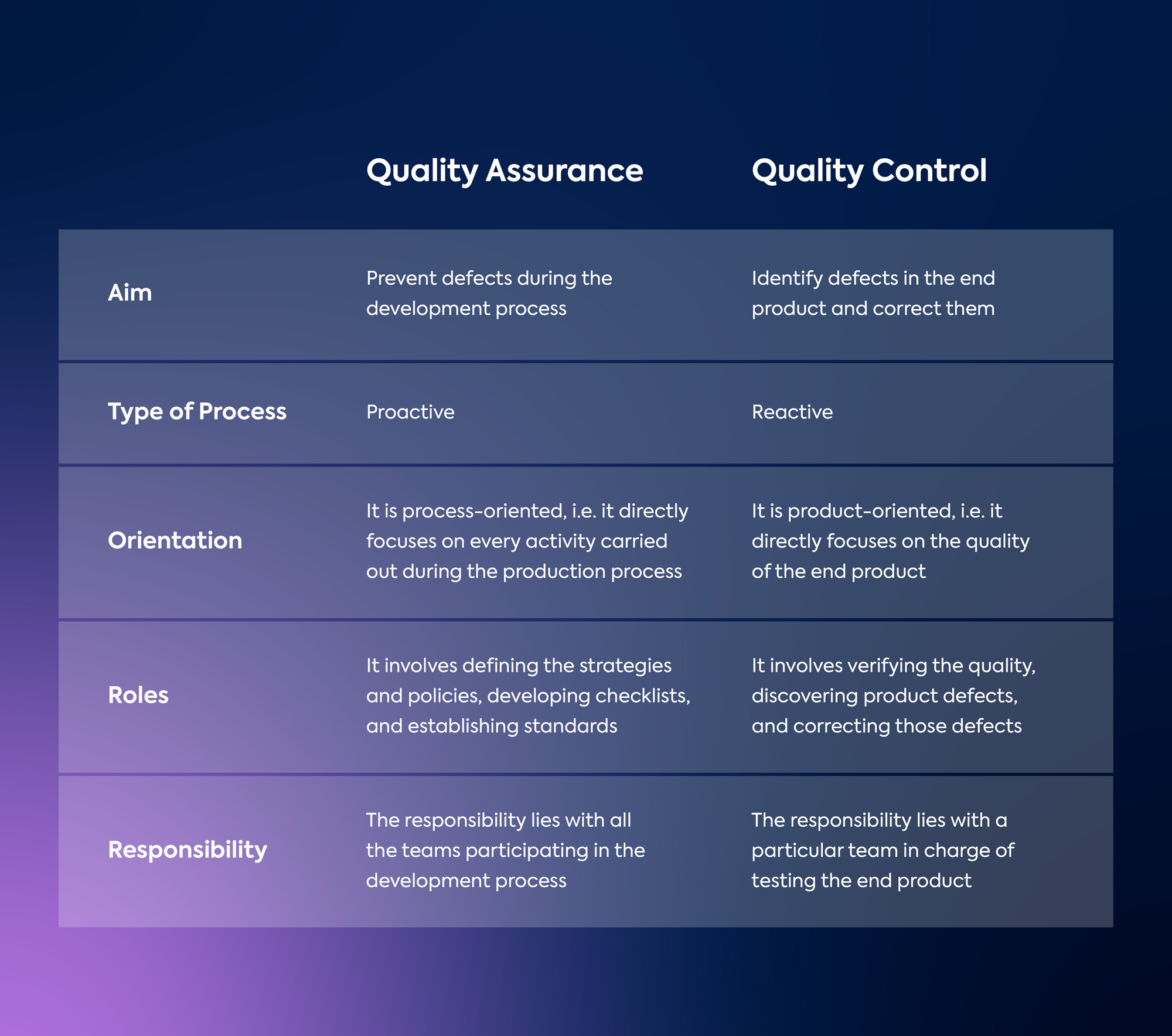You often ask us how you manage to deliver a product of the highest quality. How do you know your deliverables match the needs of your client? What can you do to ensure that? The answer to all these questions lies in Quality Assurance (QA) and Quality Control (QC).
Quality of product is extremely important when you want to stand out in the market. Quality assurance (QA) and quality control (QC) are two vital processes that businesses use to ensure the quality of their products or services. While both are essential for maintaining quality, they are distinct from each other.
QA focuses on preventing defects and ensuring that the entire process of product development or software development meets certain standards. QC, on the other hand, focuses on identifying defects and fixing them before the product or service is delivered to customers. Understanding the difference between these two processes is crucial for businesses looking to maintain quality and gain a competitive advantage.
So, let us discuss in this blog Difference Between QA & QC in Software Testing, Roles and Responsibilities of Quality Assurance and Quality Control, Benefits of implementing a robust QA and QC process and Best Practices For Quality Assurance And Quality Control.
Quality Assurance (QA) & Quality Control (QC)
According to ISO Clause 3.2.11, Quality Assurance is a part of quality management systems, which focuses on providing confidence that quality requirements will be fulfilled. Simply put, QA ensures that the end product matches the highest quality standards.
According to ISO Clause 3.2.10, Quality Control is also a part of quality management systems focused on fulfilling quality requirements. It involves a set of activities focused on detecting and correcting defects or deviations in the final product, making sure it meets the desired specifications and customer expectations.
Difference Between QA & QC in Software Testing

Roles and Responsibilities of Quality Assurance and Quality Control
Objectives
The principal objective of QA and QC is to follow the processes and meet the standards set by the stakeholders for the development process. At Rootquotient, these standards are set by experts to ensure that the end product will meet the best quality in the market.
Methods
Some methods of Quality Assurance include:
- Continuous Improvement: This involves constantly reviewing and improving processes to enhance the quality of the end product or service.
- Quality Planning: This involves defining quality standards and metrics, creating a plan to meet these standards, and ensuring that everyone involved in the process is aware of them.
- Quality Auditing: This involves evaluating and verifying that the products or services produced meet the defined quality standards.
Risk Management: This involves identifying potential risks that could negatively impact the quality of the product or service and creating a plan to mitigate those risks.
Some of the methods of QC include:
- Inspection: This involves physically examining a product or service to ensure that it meets the required specifications.
- Testing: This involves subjecting a product or service to various tests to ensure that it performs as expected.
- Six Sigma: This is a data-driven approach that aims to eliminate defects in a production process and improve quality.
- Root cause analysis (RCA): This is a method used to identify the underlying cause of defects or problems in a production process so that they can be addressed and eliminated.
Tools
Here are some of the tools used for QA and QC:
Cost-Benefit Analysis
It is a method to compare the total cost required for the QA and QC process to the total expected outcomes.
Fishbone Diagrams
These are diagrams used to map the development process in a way such that the root cause for bugs and glitches can be easily identified.
Control Charts
These are graphs used in the development process to showcase the timeline of the project and to identify whether the process is under controlled conditions.
Cost of Quality
It is the total cost required for achieving the quality agreed upon by stakeholders
Benchmarking
It is the process of comparing your product with a similar best product developed by another company to establish whether your product is of superior quality.
Inspection
It is the process of measuring, examining, gauging, and testing the end product to determine its quality.
Testing
It is the process of conducting performance tests on the end product so as to determine its quality
Collaboration of Quality Assurance and Quality Control
For a product to be of the highest grade, a collaboration between QA and QC is important. Without conducting both processes, you will not be able to identify the exact source of defects. This will also lead to increased costs as the need to repeat the development processes might arise, or bugs might show up after the product is delivered. That is why the collaboration of QA and QC is important.
According to a study conducted by Jinesh D. Kamdar, published in IJSDR Journal, the rate of rejection was drastically reduced on implementation of the Root cause analysis (RCA) method — one of the methods of QC.
Benefits of implementing a robust QA and QC process
The following are the benefits of implementing a robust QA process:
- Improves control over the entire process
- Ends up in cost reduction as errors are avoided in the process
- Develops an internal process for checks and balances
- It makes QC easier and less time-consuming
- Increases software testing efficiency
The following are the benefits of implementing a robust QC process:
- Products are tailored as per the customers' requirements
- Yields high-quality products, which creates a good brand image and ultimately boosts sales
- Increases efficiency and reduces the cost
- Reduction rates are reduced if not eliminated, which leads to a reduction in the cost of rejection
The Potential Consequences of Neglecting QA and QC
Neglecting QA and QC processes or not having a Quality Management System in place can lead to:
- Decreased product quality
- Increased costs
- Safety risks
- Legal consequences
- Delays in product release
- Wasted resources
- Loss of competitive advantage
Difficulty in identifying root causes
The Space Shuttle Challenger disaster in 1986 resulted in the loss of all seven crew members and was caused by a faulty O-ring seal. The failure of the O-ring could have been avoided with the help of proper Quality Control procedures.
Best Practices For Quality Assurance And Quality Control
The best practices for Quality Assurance and Quality Control are
- Define clear quality objectives for each product to ensure that everyone involved understands what quality means and how it will be measured.
- Involve all stakeholders in the QA and QC processes to ensure everyone works towards the same quality goals.
- Use established standards and guidelines, such as ISO 9001 or Six Sigma.
- Conduct regular audits of the QA and QC processes to ensure they are being followed and identify improvement areas.
- Use data and metrics to measure quality and identify trends.
- Perform risk assessments to identify potential quality risks and develop strategies for managing those risks.
- Implement a continuous improvement process to identify and address quality issues as they arise and continually improve the QA and QC processes.
- Use automation, technology, testing tools and software to streamline the QA and QC processes.
QA and QC, even though they are different processes, work towards a common goal of delivering the highest quality product. Each process has its own set of objectives, methods, and tools. QA and QC processes are very vital if you want to maintain your brand recognition, reduce costs, and retain clients. Generally, the cost of poor quality (COPQ) is often 10% to 15% of the operations. Thus, avoiding QA and QC will only lead to negative consequences for your company.
